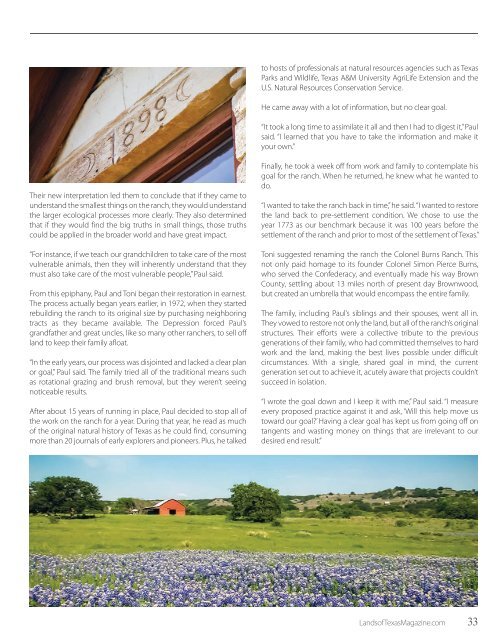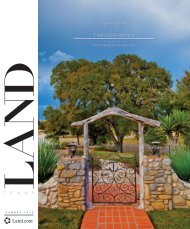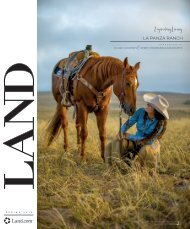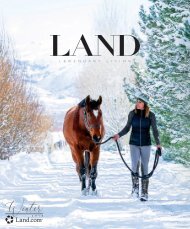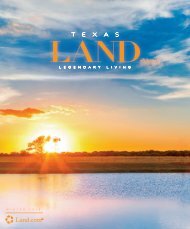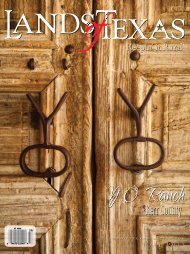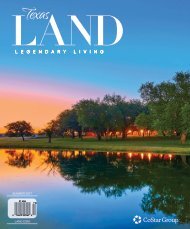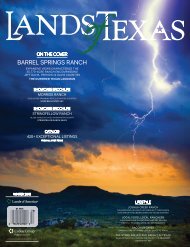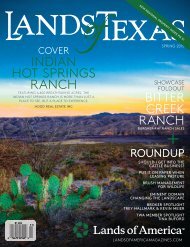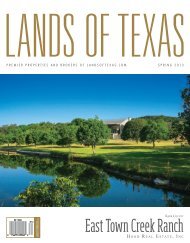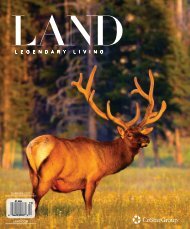Create successful ePaper yourself
Turn your PDF publications into a flip-book with our unique Google optimized e-Paper software.
to hosts of professionals at natural resources agencies such as Texas<br />
Parks and Wildlife, Texas A&M University AgriLife Extension and the<br />
U.S. Natural Resources Conservation Service.<br />
He came away with a lot of information, but no clear goal.<br />
“It took a long time to assimilate it all and then I had to digest it,” Paul<br />
said. “I learned that you have to take the information and make it<br />
your own.”<br />
Their new interpretation led them to conclude that if they came to<br />
understand the smallest things on the ranch, they would understand<br />
the larger ecological processes more clearly. They also determined<br />
that if they would find the big truths in small things, those truths<br />
could be applied in the broader world and have great impact.<br />
“For instance, if we teach our grandchildren to take care of the most<br />
vulnerable animals, then they will inherently understand that they<br />
must also take care of the most vulnerable people,” Paul said.<br />
From this epiphany, Paul and Toni began their restoration in earnest.<br />
The process actually began years earlier, in 1972, when they started<br />
rebuilding the ranch to its original size by purchasing neighboring<br />
tracts as they became available. The Depression forced Paul’s<br />
grandfather and great uncles, like so many other ranchers, to sell off<br />
land to keep their family afloat.<br />
“In the early years, our process was disjointed and lacked a clear plan<br />
or goal,” Paul said. The family tried all of the traditional means such<br />
as rotational grazing and brush removal, but they weren’t seeing<br />
noticeable results.<br />
After about 15 years of running in place, Paul decided to stop all of<br />
the work on the ranch for a year. During that year, he read as much<br />
of the original natural history of Texas as he could find, consuming<br />
more than 20 journals of early explorers and pioneers. Plus, he talked<br />
Finally, he took a week off from work and family to contemplate his<br />
goal for the ranch. When he returned, he knew what he wanted to<br />
do.<br />
“I wanted to take the ranch back in time,” he said. “I wanted to restore<br />
the land back to pre-settlement condition. We chose to use the<br />
year 1773 as our benchmark because it was 100 years before the<br />
settlement of the ranch and prior to most of the settlement of Texas.”<br />
Toni suggested renaming the ranch the Colonel Burns Ranch. This<br />
not only paid homage to its founder Colonel Simon Pierce Burns,<br />
who served the Confederacy, and eventually made his way Brown<br />
County, settling about 13 miles north of present day Brownwood,<br />
but created an umbrella that would encompass the entire family.<br />
The family, including Paul’s siblings and their spouses, went all in.<br />
They vowed to restore not only the land, but all of the ranch’s original<br />
structures. Their efforts were a collective tribute to the previous<br />
generations of their family, who had committed themselves to hard<br />
work and the land, making the best lives possible under difficult<br />
circumstances. With a single, shared goal in mind, the current<br />
generation set out to achieve it, acutely aware that projects couldn’t<br />
succeed in isolation.<br />
“I wrote the goal down and I keep it with me,” Paul said. “I measure<br />
every proposed practice against it and ask, ‘Will this help move us<br />
toward our goal?’ Having a clear goal has kept us from going off on<br />
tangents and wasting money on things that are irrelevant to our<br />
desired end result.”<br />
LandsofTexasMagazine.com<br />
33


